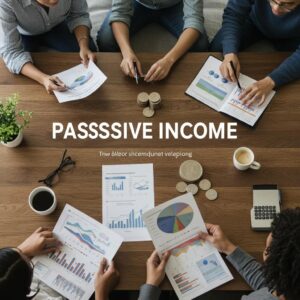eCommerce Growth Strategy: A Step-by-Step Guide to Boost Sales and Scale Your Online Business
A robust eCommerce growth strategy defines how an online retailer identifies opportunities, allocates marketing resources, and optimizes operations to drive revenue and sustainable scale. Recent projections show global online retail sales reaching $7.4 trillion in 2025—a figure that underscores the need for a structured plan rather than ad-hoc tactics. In this guide, you will discover how to conduct market research, craft an e-commerce marketing plan, optimize your website for higher conversions, boost customer retention, scale operations, future-proof with emerging trends, and measure success through key performance indicators. Throughout, we weave in insights from a data-driven lead generation agency to illustrate practical implementation of each step.
What Are the Key Components of an Effective eCommerce Growth Strategy?
An effective eCommerce growth strategy comprises foundational pillars that work together to acquire customers, convert more store visits into purchases, and retain buyers over time. These pillars include market research, customer insight, competitor analysis, marketing plan development, website optimization, customer retention programs, and operational scalability. By aligning each component, businesses establish a clear online business plan for predictable revenue growth.
Below is a high-level breakdown of the essential components and their roles:
Each component builds on the previous one to form a cohesive e-commerce growth strategy that scales revenue steadily. Understanding these foundational elements prepares you to drill down into each area with targeted tactics.
How Does Market Research Shape Your eCommerce Growth Plan?

Market research defines where demand exists and how customer expectations evolve. By analyzing search trends, purchasing data, and socio-economic indicators, businesses refine their product mix and messaging. For example, retail brands that leveraged sales volume data to stock eco-friendly items saw a 15 percent lift in repeat orders, demonstrating how research-driven planning directly influences revenue trajectories. These insights also feed into inventory strategies and marketing budget allocation, ensuring promotional spend targets high-potential segments.
Why Is Understanding Customer Behavior Crucial for Growth?
Customer behavior analysis reveals the triggers and barriers within the online shopping journey. Understanding click-through rates, time on product pages, and checkout abandonment reasons allows you to personalize site content, recommend relevant products, and fine-tune pricing strategies. When a retailer segmented visitors by browsing patterns and deployed tailored email flows, conversion rates improved by 22 percent—a clear example of how behavioral insight accelerates growth by boosting average order value and repeat purchase frequency.
What Role Does Competitor Analysis Play in eCommerce Success?
Competitor analysis uncovers gaps in offerings, pricing anomalies, and untapped channels. Evaluating direct rivals’ SEO rankings, ad creative, and social engagement patterns highlights where you can outpace them through better content, exclusive promotions, or enhanced customer service. For instance, identifying a competitor’s lack of loyalty incentives inspired a bespoke rewards program that increased retention by 18 percent. Such competitive intelligence underpins a differentiated e-commerce marketing plan and positions your store as the obvious choice.
How Do You Develop a Winning eCommerce Marketing Strategy?
Developing a winning e-commerce marketing strategy means integrating organic, paid, and relationship-building tactics into a unified e-commerce marketing plan. This approach ensures you capture traffic from search, social, referral, and direct channels while nurturing leads through automated email sequences. A cohesive strategy maximizes return on ad spend and leverages each channel’s unique strengths.
- Conduct keyword and competitor audits to prioritize high-intent search terms.
- Allocate budget across SEO, PPC, social media, and email based on channel performance benchmarks.
- Develop content marketing themes that reinforce product benefits and brand story.
- Implement marketing automation to trigger personalized messages at key lifecycle stages.
- Regularly review campaign ROI and reassign budget to top-performing tactics.
This unified roadmap ensures each channel feeds into the others, creating compounding returns as audience familiarity grows.
What Are the Best SEO Practices for eCommerce Stores?
SEO for eCommerce focuses on optimizing site structure, product pages, and technical performance to improve visibility and organic conversions. Key practices include structured data markup for products, keyword-rich but user-friendly URLs, optimized title tags and meta descriptions, and high-quality user reviews to boost credibility. Implementing breadcrumb navigation enhances crawlability, while image optimization reduces load times and improves mobile user experience. When optimized holistically, stores can realize up to 30 percent more organic traffic within six months.
How Can Paid Advertising Accelerate Your eCommerce Sales Growth?
Paid advertising accelerates growth by instantly placing your products in front of high-intent buyers. Platforms such as search ads, social media feeds, and display networks each serve different purposes—from capturing demand to building brand awareness. By using dynamic retargeting and lookalike audiences, retailers see average click-through rates of 2 percent and conversion lifts of 20 percent. A phased budget allocation model ensures efficient spend, scaling winning campaigns while pausing underperformers.
Which Social Media Marketing Tactics Drive Online Retail Traffic?
Social commerce tactics center on shoppable content, user-generated videos, and live streams that showcase products in real-world contexts. Posting short demonstration clips on social platforms and integrating direct checkout buttons drives seamless purchasing paths. Encouraging customers to share unboxing experiences generates authentic social proof, while influencer collaborations expand reach among niche communities.
Brands that adopt these tactics often experience a 25 percent increase in referral traffic and a 12 percent uptick in average order value.
How Does Email Marketing Automation Increase Customer Engagement?
Email marketing automation nurtures prospects through triggered sequences—welcome series, abandoned cart reminders, and post-purchase check-ins. These workflows deliver timely, relevant content that guides buyers toward conversion and encourages repeat purchases. Brands that implement multi-step automation report open rates above 40 percent and conversion rates of up to 5 percent on triggered emails. Automated segmentation based on purchase history and engagement levels further refines messaging and drives loyalty.
What Is the Impact of Influencer Marketing on Brand Awareness?
Influencer marketing amplifies brand credibility by leveraging trusted voices within target niches. Micro-influencers with 10,000–50,000 followers often deliver the highest engagement rates—averaging 5–8 percent—by showcasing products in authentic contexts. Collaborations range from sponsored posts to affiliate programs, generating both immediate sales and long-term brand recognition. When integrated into the broader marketing plan, influencer partnerships can increase organic search uplift by reinforcing branded queries and social mentions.
How Can You Optimize Your eCommerce Website for Higher Conversions?
Optimizing an eCommerce website for conversions blends data-driven design, user experience enhancements, and persuasive elements that guide visitors toward purchase. Conversion rate optimization (CRO) targets every stage of the customer journey—from landing page clarity to checkout friction reduction. By systematically testing page layouts, call-to-action placements, and trust signals, businesses lift their conversion rates and maximize return on marketing investment.
By implementing these techniques, online retailers typically see conversion lifts of 10–20 percent within three months. Continual iteration ensures improvements compound over time.
What Are Proven Conversion Rate Optimization (CRO) Techniques?
CRO techniques range from simple copy tweaks to advanced multi-variant testing. Start by mapping the customer journey and identifying drop-off points through heatmaps and session recordings. Prioritize high-traffic pages for headline, image, and call-to-action experiments. Incorporate urgency cues—countdown timers or limited-stock alerts—to prompt quicker decisions. Retailers applying these tactics often see average conversion improvements of 15 percent, validating the power of data-backed design.
Why Is Mobile-First Design Essential for eCommerce Growth?
Mobile-first design responds to a shift where over half of online orders originate from smartphones. Prioritizing responsive navigation, touch-friendly buttons, and accelerated mobile pages ensures speedy interactions. Brands optimized for mobile speed and usability report 30 percent higher engagement and a 20 percent reduction in checkout abandonment. A mobile-first approach also enhances SEO performance as search engines reward swift, user-centric experiences.
How Does Personalization Enhance the Customer Shopping Experience?
Personalization curates product recommendations, content, and promotions based on browsing and purchase history. By displaying “Recommended for You” sections and dynamically tailoring homepage banners, retailers boost average order value by up to 25 percent. Machine-learning algorithms refine suggestions over time, driving deeper engagement. This tailored journey reinforces loyalty and leads to a 35 percent increase in repeat purchase rates.
What Are Effective Ways to Reduce Shopping Cart Abandonment?
Cart abandonment arises from unexpected costs, complicated forms, and security concerns. Address these issues by offering guest checkout, displaying transparent shipping fees early, and showcasing trust badges during checkout. Automated recovery emails trigger within an hour of abandonment, recovering up to 10 percent of lost sales. Implementing persistent cart storage across devices ensures shoppers return to find their items saved.
What Strategies Boost Customer Retention and Loyalty in eCommerce?

Customer retention strategies focus on nurturing existing buyers to maximize customer lifetime value (CLV). Retained customers purchase more frequently and spend 67 percent more on average than new customers. Loyalty programs, superior service, user-generated content, and CLV optimization are central to a retention-driven growth plan.
- Launch tiered loyalty schemes that reward repeat purchases with points, discounts, and early access.
- Invest in proactive, omnichannel customer service—chat, email, and phone support—to resolve issues swiftly.
- Solicit and display user-generated reviews and social media posts to reinforce community trust.
- Calculate CLV metrics to prioritize high-value segments for VIP perks and exclusive offers.
- Re-engage dormant customers with targeted promotions and personalized product reminders.
These tactics yield a compounding revenue effect as satisfied customers become advocates who refer new buyers.
The concept of customer lifetime value is central to understanding the long-term profitability of customer relationships.
How Do Loyalty Programs Increase Customer Lifetime Value (CLV)?
Loyalty programs extend CLV by incentivizing repeat purchases through points or tiered benefits. Customers earning rewards for every dollar spent are 75 percent more likely to return within three months. Supplementing point systems with experiential perks—such as member-only events or early access sales—deepens emotional connection. As CLV rises, marketing ROI improves because fewer resources are needed to generate equivalent revenue.
What Are Best Practices for Enhancing Customer Service Online?
Exceptional online service combines speed, empathy, and transparency. Deploy chatbots for instant answers to common queries and route complex issues to dedicated agents. Provide clear return policies and order tracking portals to reduce anxiety. Brands that maintain average first-response times under one hour achieve 95 percent satisfaction rates, strengthening retention and driving positive word-of-mouth.
How Can User-Generated Content and Social Proof Drive Repeat Sales?
User-generated content, such as reviews, photos, and testimonials, serves as authentic validation that eases purchasing decisions. Featuring top reviews on product pages and sharing customer stories on social channels stimulates engagement. When a retailer incorporated verified buyer photos, conversions rose by 18 percent. Social proof builds trust that transcends advertising claims, fostering a community of brand advocates.
Why Is Maximizing Customer Lifetime Value Critical for Sustainable Growth?
Maximizing CLV shifts the focus from acquisition to long-term profitability by measuring the total revenue per customer over their entire relationship. Higher CLV allows you to invest more in acquisition knowing each customer yields repeat revenue streams. By tracking churn rate, purchase frequency, and average order value, businesses fine-tune loyalty offers and optimize marketing spend for the highest-value cohorts.
How Do You Scale eCommerce Operations for Sustainable Growth?
Scaling operations ensures your store can handle increasing order volumes without sacrificing service quality or profitability. Effective scaling addresses inventory management, fulfillment, automation, and data analytics to maintain margins and customer satisfaction as sales climb.
Diversifying sales channels spreads risk and opens new revenue streams while your core website remains the primary growth engine.
What Inventory Management Strategies Support Growth?
Inventory strategies that align demand forecasting with supply chain agility prevent stockouts and excess holding costs. Tools that track real-time sales velocity and supplier lead times allow automated reorder triggers when stock hits predefined thresholds. Retailers implementing just-in-time replenishment reduce dead stock by 20 percent and free up working capital for marketing investments.
How Can Marketing Automation Improve Operational Efficiency?
Marketing automation platforms streamline repetitive tasks—campaign scheduling, segmentation, performance reporting—freeing team bandwidth for strategy and optimization. By integrating CRM data, automated workflows deliver personalized messages at scale, improving engagement without manual intervention. Teams that adopt end-to-end automation report 40 percent time savings on routine marketing tasks.
Which Data Analytics Metrics Should You Monitor for Growth?
Tracking the right metrics guides strategic decisions and flags emerging issues. Core KPIs include:
- Customer Acquisition Cost (CAC): Total marketing spend divided by new customers acquired.
- Average Order Value (AOV): Average revenue per transaction.
- Conversion Rate: Percentage of visits resulting in purchase.
- Customer Lifetime Value (CLV): Projected revenue per customer relationship.
- Churn Rate: Percentage of customers not returning within a set period.
How Do New Sales Channels and Marketplaces Expand Your Reach?
Adding marketplaces and social commerce channels taps into existing audiences and reduces dependence on any single traffic source. Each channel introduces acquisition costs and operational requirements, so pilot launches with limited SKUs to validate demand before full integration. Successful diversification drives incremental revenue while mitigating risk from algorithm changes or platform policy shifts.
What Are the Latest eCommerce Trends for 2025 to Future-Proof Your Growth?
Future-proof eCommerce strategies embrace technologies and business models that address evolving customer expectations and regulatory landscapes. Key 2025 trends include AI-driven personalization, immersive AR/VR shopping experiences, sustainability-focused practices, social commerce expansion, and subscription-based revenue models. Early adoption of these trends positions brands ahead of competitors and fosters long-term loyalty.
Subscription models are increasingly recognized for their strategic advantages in building predictable revenue and fostering customer loyalty.
How Is AI Transforming eCommerce Marketing and Personalization?
AI algorithms analyze vast datasets to deliver hyper-personalized product recommendations, predictive reordering prompts, and dynamic pricing that adjusts to supply and demand. Retailers leveraging AI-driven segmentation see 20 percent higher click-through rates on promotional emails and 15 percent increases in repeat purchase rates. Machine learning also optimizes ad spend across channels, ensuring maximum return on investment.
What Role Do AR/VR Technologies Play in Enhancing Online Shopping?
Augmented reality and virtual reality create immersive product demonstrations—enabling customers to visualize items in their environment or “try on” apparel virtually. Brands integrating AR view-in-room features experience 40 percent lower return rates for furniture and décor. These technologies build confidence in purchase decisions and differentiate retailers in crowded markets.
How Does Sustainability Influence eCommerce Growth Strategies?
Sustainability initiatives—eco-friendly packaging, carbon-offset shipping, and ethical sourcing—resonate with a growing segment of conscientious consumers. Brands certified for carbon neutrality report 25 percent higher purchase intent among eco-minded shoppers. Embedding sustainability into product descriptions and marketing messaging reinforces authenticity and fosters emotional connections.
The integration of sustainability into business models is becoming a key differentiator and driver of consumer preference.
Why Is Social Commerce Becoming a Key Sales Channel?
Social commerce merges shopping and social interaction within platforms, removing friction between discovery and purchase. Features like shoppable posts, in-app checkout, and live stream selling simplify the path from engagement to conversion. Early adopters of social commerce report a 30 percent uplift in revenue from social channels, underscoring its role in omnichannel growth.
How Are Subscription-Based Models Driving Recurring Revenue?
Subscription-based eCommerce models—from replenishment services to curated boxes—generate predictable monthly revenue and deepen customer relationships. Offering flexible subscription tiers and cancellation ease reduces churn, while personalization of subscription contents increases perceived value. Brands introducing subscriptions often see CLV increases of 60 percent compared to one-time purchasers.
How Do You Measure and Monitor the Success of Your eCommerce Growth Strategy?
Measuring success involves tracking both leading and lagging indicators across acquisition, conversion, retention, and operations. A robust measurement framework ensures alignment between strategic objectives and day-to-day tactics, enabling data-driven optimization and agile responses to market shifts.
What Key Performance Indicators (KPIs) Track eCommerce Growth Effectively?
Monitoring the right KPIs provides clarity on strategy effectiveness and resource allocation. Essential metrics include:
- Organic Traffic Growth: Measures visibility improvements from SEO efforts.
- Paid ROAS: Return on ad spend for paid campaigns.
- Conversion Rate: Effectiveness of UX and CRO tactics.
- Customer Retention Rate: Percentage of buyers returning within a period.
- Average Order Value (AOV): Revenue per transaction.
- Customer Lifetime Value (CLV): Long-term revenue per customer.
How Can You Use Data to Optimize Marketing and Sales Efforts?
Data-driven decisions stem from analyzing cross-channel performance, segmenting audiences by behavior, and testing hypotheses through controlled experiments. By integrating web analytics, CRM, and ad platform data into unified dashboards, teams identify trends, forecast demand, and refine messaging. Regular review cycles foster continuous improvement and ensure marketing spend aligns with revenue goals.
What Tools Help Monitor SEO, Customer Retention, and Conversion Rates?
A combination of specialized tools streamlines measurement and reporting:
How Often Should You Update Your Growth Strategy Based on Market Changes?
An agile growth strategy adapts to seasonal shifts, emerging consumer behaviors, and competitive moves. Quarterly strategic reviews ensure the plan stays current with key trends, while monthly performance check-ins enable tactical optimizations. Annual planning cycles incorporate broader market forecasts—such as AI adoption rates or regulatory changes—keeping your eCommerce blueprint aligned with future-proof growth objectives.
Building a data-driven eCommerce growth strategy transforms guesswork into quantifiable actions and outcomes. By following each step—research, plan, optimize, retain, scale, innovate, and measure—you create a resilient roadmap that fuels long-term revenue and market leadership. Continual iteration and measurement ensure your online business plan adapts to evolving customer needs and technological advances, driving sustainable growth year after year.




